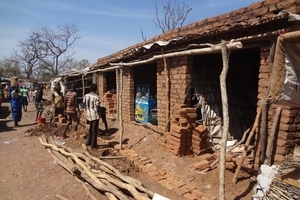
It’s been nine months since we last visited the Yida Refugee Camp in South Sudan and returning now it’s amazing what has changed – it’s also deeply troubling what hasn’t.
Over the past year and a half this camp has been the destination of refugees fleeing massive human rights violations and a humanitarian crisis in Sudan’s Southern Kordofan state.
When we were here in April, there were just over 20,000 refugees at Yida but hundreds more were arriving every day.
Now the camp is home to about 60,000 Nuba refugees from Sudan. The rate of arrivals, which had slowed considerably during this region’s relentless rainy season, has picked up again with an average of about 1,000 arrivals per week in January.
And that is the big change. The camp has grown considerably – nearly threefold in eight months.
And alongside the massive influx there is more here. The market bustles. Homes are being built everywhere: not just the thatch grass huts of new arrivals, but more comfortable and sturdy brick. And with all this growth there seems a much calmer mood in the camp.
But there is much that has not changed at all. And that is deeply worrying.
First and foremost, of course, the widespread human rights violations and breaches of humanitarian law continue on the other side of the border.
Today we interviewed several refugees who have arrived at Yida over the past few weeks. All had tales that were so despairingly similar to what we heard last year.
Aerial bombardment by Sudanese Air Force Antonov bombers continues. People shared with us many names of relatives and neighbours – as young as a one-year-old baby – who have been killed and badly injured as the inherently and totally indiscriminate Antonov bombs have rained down. One man showed us the scars of a recent shrapnel wound.
Alongside this terror in the skies, everyone talked of the terrible toll of hunger in Southern Kordofan.
Bombing has destroyed food stores, ruined fields and made it impossible to cultivate and plant anew. As they did in 2012, people are fleeing to Yida because they are terrified of both bombs and starvation.
The other element that has not changed is the UN’s worry that Yida’s location – close to the Sudan/South Sudan border and along a strategic road – is too dangerous. The UN’s refugee agency, UNHCR, wants the refugees to move away from Yida. Last year they tried to encourage refugees to move two hours further south to Nyeel Camp. Tents had been erected for 9,000 but in the end fewer than 10 per cent of that number ever made the move. For a whole host of reasons, including the fact that Nyeel was prone to flooding in the rainy season, refugees at Yida stayed put. The Nyeel move has been abandoned.
Now there are plans to move refugees to a different location – including opening a new camp by March which, like Yida, will be close to the border, but not along the same strategic road.
However, this new location is closer to an area controlled by the Sudanese military, not the opposition Sudanese Peoples Liberation Army – North which controls the areas close to Yida.
Many refugees we interviewed, therefore, once again insisted they will not move. They feel well settled at Yida; and are fearful about the new camp’s proximity to the Sudanese military. As one women said to us, “why would refugees want to move closer to their enemy?”
It is a difficult predicament and one we will continue to explore in the days ahead. Several refugees told us that they would rather return to the Nuba Mountains than make the move to the new camp. That obviously is not the answer.

